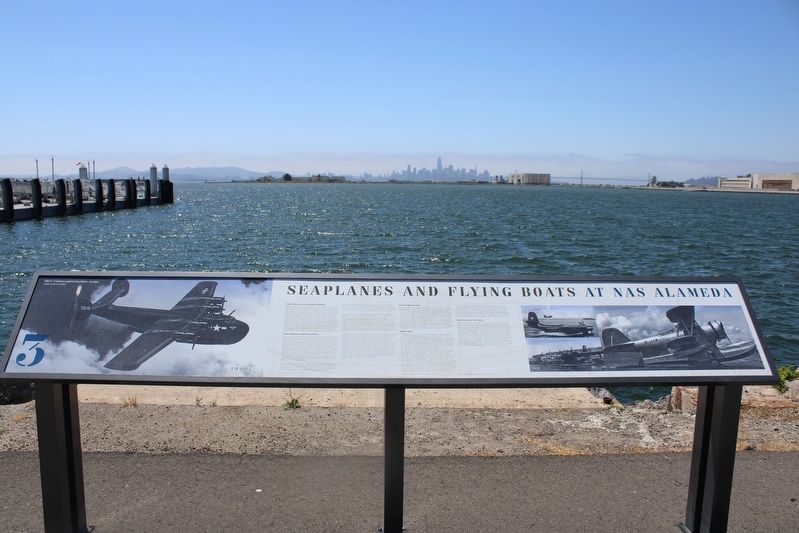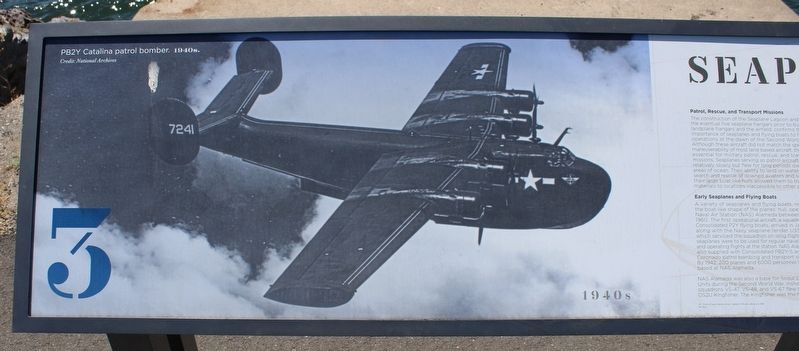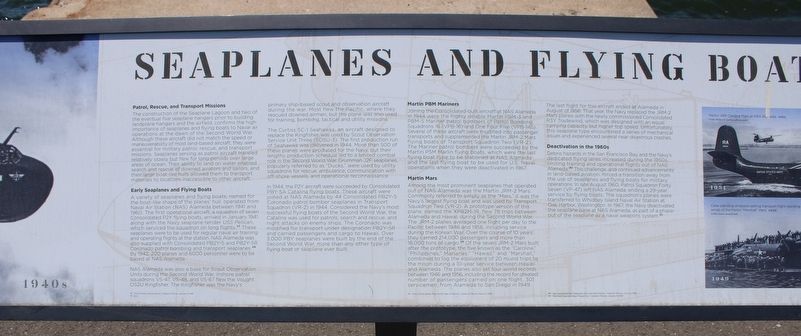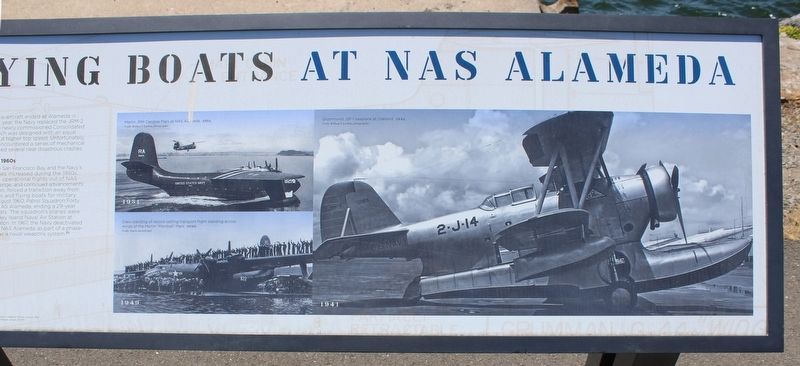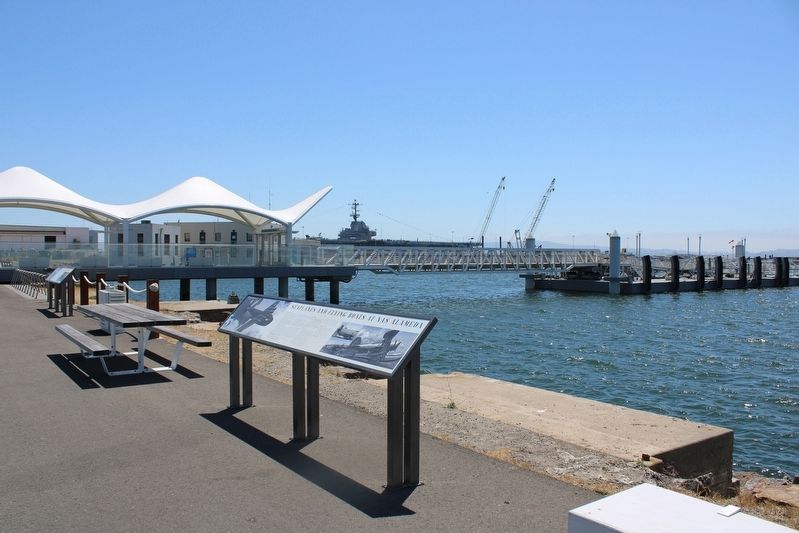Alameda in Alameda County, California — The American West (Pacific Coastal)
Seaplanes and Flying Boats at NAS Alameda
The construction of the Seaplane Lagoon and two of the eventual five seaplane hangars prior to building landplane hangars and the airfield, confirms the high importance of seaplanes and flying boats to Naval air operations at the dawn of the Second World War. Although these aircraft did not match the speed or maneuverability of most land-based aircraft, they were essential for military patrol, rescue, and transport missions. Seaplanes serving as patrol aircraft traveled relatively slowly but flew for long periods over large areas of ocean. Their ability to land on water enabled search and rescue of downed aviators and sailors, and their large boat-like hulls allowed them to transport materials to locations inaccessible to other aircraft.
Early Seaplanes and Flying Boats
A variety of seaplanes and flying boats, named for the boat-like shape of the planes' hull, operated from Naval Air Station (NAS) Alameda between 1941 and 1960. The first operational aircraft, a squadron of seven Consolidated P2Y flying boats, arrived in January 1941 along with the Navy seaplane tender USS Pelican, which serviced the squadron on long flights.17 These seaplanes were to be used for regular naval air training and operating flights at the station. NAS Alameda was also supplied with Consolidated PB2Y-5 and PB2Y-5R Coronado patrol bombing and transport seaplanes.18 By 1942, 200 planes and 6000 personnel were to be based at NAS Alameda.
NAS Alameda was also a base for Scout Observation Units during the Second World War. Inshore patrol squadrons VS-47, VS-48, and VS-67 flew the Vought OS2U Kingfisher. The Kingfisher was the Navy's primary ship-based scout and observation aircraft during the war. Most flew the Pacific, where they rescued downed airmen, but the plane was also used for training, bombing, tactical and utility missions.
The Curtiss SC-1 Seahawks, an aircraft designed to replace the Kingfisher, was used by Scout Observation Service Unit Three (SOSU-3). The first production run of Seahawks was delivered in 1944. More than 500 of these planes were produced for the Navy, but their lengthy production schedule led to a limited combat role in the Second World War. Grumman J2F seaplanes, popularly referred to as "Ducks," were used by utility squadrons for rescue, ambulance, communication with off-shore vessels, and operational reconnaissance.
In 1944, the P2Y aircraft were succeeded by Consolidated PBY-5A Catalina flying boats. These aircraft were joined at NAS Alameda by 44 Consolidated PB2Y-5 Coronado patrol bomber seaplanes in Transport Squadron (VR-2) in 1944. Considered the Navy's most
successful flying boats of the Second World War, the Catalina was used for patrols, search and rescue, and night attacks on enemy ships. The Coronado was modified for transport under designation PB2Y-5R and carried passengers and cargo to Hawaii. Over 3,000 PBY seaplanes were built by the end of the Second World War, more than any other type of flying boat or seaplane ever built.
Martin PBM Mariners
Joining the Consolidated-built aircraft at NAS Alameda in 1944 were the highly reliable Martin PBM-3 and PBM-5 Mariner patrol bombers of Patrol Bombing Squadrons 16 (VPB-16) and One Four Five (VPB-145). Several of these aircraft were modified into passenger transports and supplemented the Martin JRM-2 Mars flying boats of Transport Squadron Two (VR-2). The Mariner patrol bombers were succeeded by the Martin P5M Marlin flying boats, which were the last flying boat type to be stationed at NAS Alameda and the last flying boat to be used for U.S. Naval operations when they were deactivated in 1967.
Martin Mars
Among the most prominent seaplanes that operated out of NAS Alameda was the Martin JRM-2 Mars. Commonly referred to simply as the "Mars," it was the Navy's largest flying boat and was used by Transport Squadron Two (VR-2). A prototype version of this plane, named the XPB2M-1R, flew 78 trips between Alameda and Hawaii during the Second World
War. The JRM-2 planes averaged one flight per day to the Pacific between 1946 and 1956, including service during the Korean War. Over the course of 10 years they carried 214,000 passengers and more than 18,000 tons of cargo.19 Of the seven JRM-2 Mars built after the prototype, the five known as the "Caroline," "Philippines," Marianas," "Hawaii," and "Marshall," combined to log the equivalent of 20 round trips to the moon during a 10-year service between Hawaii and Alameda. The planes also set four world records between 1946 and 1956, including the record for greatest number of passengers carried on one flight, 301 servicemen, from Alameda to San Diego in 1949.
The last flight for this aircraft ended at Alameda in August of 1956. That year, the Navy replaced the JRM-2 Mars planes with the newly commissioned Consolidated R3Y Tradewind, which was designed with an equal carrying capacity, but higher top speed. Unfortunately, this seaplane type encountered a series of mechanical issues and experienced several near disastrous crashes.
Deactivation in the 1960s
Debris hazards in the San Francisco Bay and the Navy's dedicated flying lanes increased during the 1950s, limiting training and operational flights out of NAS Alameda.20 This challenge, and continued advancements in land-based aviation, forced a transition
away from the use of seaplanes and flying boats for military operations. In late August 1960, Patrol Squadron Forty Seven (VP-47) left NAS Alameda, ending a 29-year service by flying boats. The squadron's planes were transferred to Whidbey Island Naval Air Station at Oak Harbor, Washington. In 1967, the Navy deactivated the seaplane base at NAS Alameda, as part of a phase-out of the seaplane as a naval weapons system.21 (Marker Number 3.)
Topics. This historical marker is listed in these topic lists: Air & Space • Waterways & Vessels. A significant historical year for this entry is 1941.
Location. 37° 46.65′ N, 122° 17.903′ W. Marker is in Alameda, California, in Alameda County. Marker is on Ferry Point north of West Oriskany Avenue, on the right when traveling south. The resin marker is mounted to metal posts to the right of the entrance to the Alameda Seaplane Lagoon Ferry Terminal. Touch for map. Marker is in this post office area: Alameda CA 94501, United States of America. Touch for directions.
Other nearby markers. At least 8 other markers are within walking distance of this marker. Seaplane Lagoon (a few steps from this marker); Aircraft Carriers and Seaplane Tenders (within shouting distance of this marker); Alameda: Bay Area Aviation Center (within shouting distance of this marker); Douglas SBD Dauntless (approx. 0.2 miles away); Grumman J2F Duck
(approx. 0.2 miles away); Vought A-7A Corvair II (approx. 0.2 miles away); Grumman F6F Hellcat (approx. 0.2 miles away); The Jimmy Doolittle Pier – Alameda Naval Air Station (approx. 0.4 miles away). Touch for a list and map of all markers in Alameda.
More about this marker.
17 “First of Navy Planes Arrive,” Oakland Tribune, January 4, 1941.
18 Ibid
19 “Navy Flying Boats Mark Tenth Year of Service,” Oakland Tribune, March 4, 1956.
20 “Bay Debris Blamed: Seaplanes Quit Alameda Station,” Oakland Tribune, June 22, 1960
21 “Alameda Seaplane Base Phased Out,” Oakland Tribune, January 19, 1967.
Inset Images:
PB2Y Catalina patrol bomber, 1940s. Credit: National Archives
Martin JRM Caroline Mars at NAS Alameda. 1951. Credit: William T. Larkins, photographer
Crew standing of record-setting transport flight standing across wings of the Martin “Marshall” Mars. 1949. Credit: Source unconfirmed
Grummond J2F-1 seaplane at Oakland. 1941. Credit: William T. Larkins, photographer
Credits. This page was last revised on September 10, 2023. It was originally submitted on September 10, 2023, by Joseph Alvarado of Livermore, California. This page has been viewed 106 times since then and 41 times this year. Photos: 1, 2, 3, 4, 5. submitted on September 10, 2023, by Joseph Alvarado of Livermore, California.
